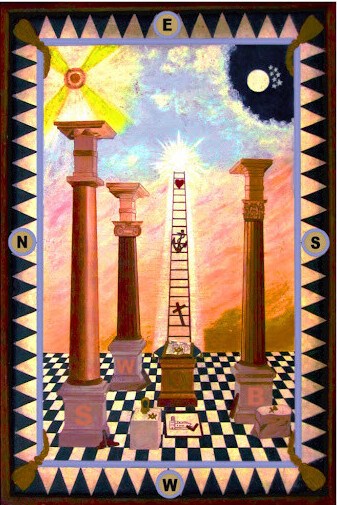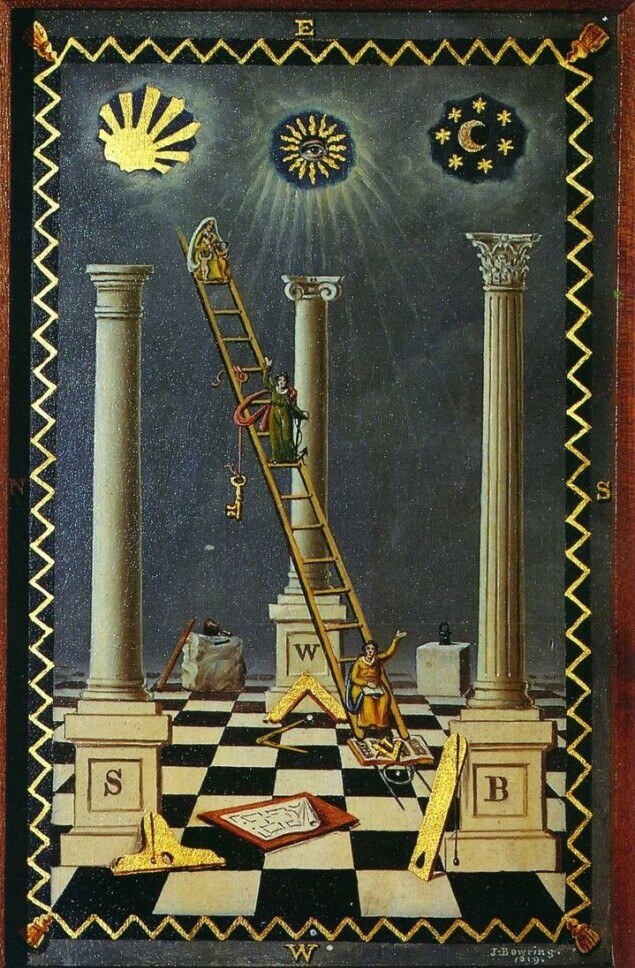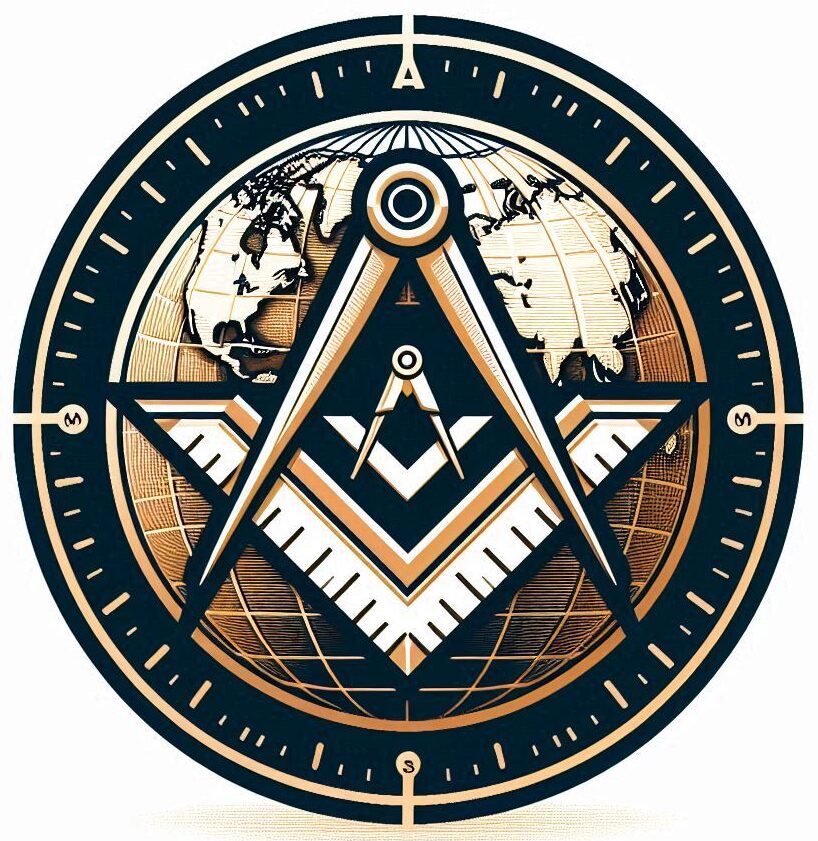Masonic Tracing Boards are a fascinating part of the rich tapestry of Freemasonry, often seen nestled within the rituals and teachings of Masonic Lodges. These are not just decorative items; they serve as visual guides for members during meetings and initiations, revealing layers of symbolism encoded within Masonic practices. By providing a visual aid, they help members understand and internalise complex esoteric concepts that words alone might struggle to convey.
The roots of these tracing boards stretch back to the early days of Freemasonry. Imagine gathering in a meeting space illuminated by flickering candlelight, with a tracing board central to discussions and teachings. These early tracing boards were often drawn right on the floor of meeting spaces or crafted on portable surfaces. This practical tool allowed Masons to outline and communicate the principles of their craft more effectively.
As Freemasonry expanded, so did the complexity and variety of these tracing boards. Each board was meticulously designed, incorporating intricate symbols that spoke directly to Masons of their values, duties, and the knowledge they aimed to pass on. Carrying symbols like the all-seeing eye, compasses, and pillars, tracing boards acted as a silent instructor, guiding members in their journey through the degrees of Masonry.
Understanding these boards is like unlocking a language visual to the informed. Tracing boards helped translate the esoteric vocabulary of Freemasonry into a visual form that was accessible yet profound, guiding Masons through both personal and collective journeys of growth and understanding. Often with an explanation of the meaning being explained to candidates when being elevated to that particular degree.
The First Designs of Masonic Tracing Boards: A Glimpse Into History
Early Masonic Tracing Boards are like time capsules, offering insights into the artistry and craftsmanship of the past. Created with care, these boards feature intricate designs that reveal much about the Masonic traditions of the time. They weren’t just practical tools; they were works of art, often reflecting the personal touch of the craftsmen who made them.
These first designs were packed with symbols designed to teach. The layouts included a range of motifs basked in allegory, like the compass and square, pillars, and steps, that were substantive to a Mason’s progression through the ranks. Imagine these symbols as a language through which Masons communicated essential truths about their journey and responsibility.
The interpretation of these symbols often varied between different lodges and regions. Tracing boards from the 18th century might look quite different from those in the 19th century due to such regional intricacies and evolving art tastes. But the core objective remained: illustration and instruction. Each element on these boards played its part in painting a full picture of Masonic philosophy and teaching.
It’s worth noting how these boards have influenced today’s practice. Even now, many lodges use modern reproductions of these original designs, preserving the visual language and continuing the tradition of teaching through these timeless tools. Walking through the history of their creation, we see how fundamental the design evolution is to the Masonic experience and how it laid down the framework for future Masonic teachings and understanding.
 A typical Tracing Board – depicting three pillars and celestial/terrestrial signage and a ladder
A typical Tracing Board – depicting three pillars and celestial/terrestrial signage and a ladder
Antique Tracing Boards: Preserving Masonic Heritage
Some of the most remarkable pieces you might come across in the world of Masonic artifacts are antique tracing boards. Each of these items holds stories of countless Masonic meetings and rites, marking the passage of time with their beautifully faded colors and intricate designs.
The allure of these collectibles goes beyond their age. For Masons and collectors alike, owning an antique tracing board means connecting with the very heart of Masonic history. Such pieces can fetch hefty sums at auctions owing to their rarity and the skill involved in their creation. They’re treasures that preserve the essence of past practices and artistic expressions from generations of Masons.
Caring for these boards requires a keen understanding of their delicate nature. Ensuring they remain well-preserved involves maintaining them in controlled environments to prevent further aging or damage. Restoration, when necessary, must be handled by experts familiar with their historical and cultural significance.
Antique tracing boards don’t just sit as museum pieces; they continue to influence modern Freemasonry. Many lodges use them as a foundation for teaching, bridging the gap between past and present. By studying old symbols and their meanings, Masons today connect with traditions that have shaped their identity over centuries.

As you can observe when looking at two similar tracing boards each differ slightly. The Freemason’s working tools are more heavily depicted in this later example, with the square, level and plumbline being more evident. This latter version also more elaborate in its design although in the former, faith hope and charity are depicted by the cross, anchor and heart, here they are depicted by having a copy of the sacred words on the knee, a key and the helping up of an infant. Such allegorical images are depicted throughout Freemasonry.
Amazon Associates Disclosure
In compliance with the Amazon Associates Operating Agreement and the U.S. Federal Trade Commission (FTC) guidelines, we want to make the following disclosure regarding the use of affiliate links on this website.
masonicregaliaworldwide.com is a participant in the Amazon Services LLC Associates Program, an affiliate advertising program designed to provide a means for sites to earn advertising fees by advertising and linking to Amazon.com and affiliated sites.
This means that when you click on product links on this site and make a purchase through Amazon, we may receive a small commission at no additional cost to you. These commissions help support the ongoing maintenance of this website, including content creation, hosting, and other expenses.
We only recommend products and services that we personally use, trust, or believe will add value to our readers. However, it’s always recommended that you conduct your own research before making any purchase based on our recommendations.
Your trust matters to us, and we are committed to providing honest, transparent content. Affiliate commissions do not influence our editorial content or product evaluations.
If you have any questions about our affiliate relationships, please feel free to reach out via our contact page.
Thank you for your support!

Hi Martin,
This article offers a wonderfully immersive look into the visual language and rich symbolism of Masonic Tracing Boards. I really appreciate how you’ve drawn out their layered role—as both artistic expressions and instructional tools that have guided generations of Freemasons. The comparison between early designs and more elaborate contemporary examples shows just how dynamic yet deeply rooted these symbols are in the Craft’s teachings.
Your exploration of allegorical elements like faith, hope, and charity—expressed in evolving visual forms—was especially thought-provoking. It’s clear that these boards are not just relics but living documents of Masonic philosophy.
Martin, I’d love to know your thoughts on how modern Masons respond to antique tracing boards today. Do you find that these historic designs still resonate strongly with newer members, or is their symbolic language sometimes overshadowed by modern interpretations?
Regards
Oren
Hi Oren,
Thanks so much for such a thoughtful comment! Really glad you enjoyed the article, tracing boards are endlessly fascinating, aren’t they?
In my experience, a lot of newer Freemasons are actually quite drawn to the antique boards. There’s something about their simplicity and slightly “mysterious” style that feels authentic and sparks curiosity. They’re like windows into the mindset of earlier Brethren, which adds a real sense of continuity with the past.
That said, modern designs definitely have their own appeal too especially when they use color and detail to highlight symbolism that can sometimes get overlooked in older boards. I think both have their place, and often they complement each other rather than compete.
Really appreciate your question, Oren it’s the kind of conversation that keeps the Craft’s symbolism alive and evolving!
Kind regards,
Martin
This was a fascinating read! I had no idea tracing boards originated as temporary chalk drawings. It’s incredible to see how they evolved into detailed, permanent tools for Masonic education. The historical insight into their transformation and symbolism really deepened my appreciation for their role in Masonic tradition. Thank you for explaining it so clearly—it’s great to learn the history behind these important and often overlooked ceremonial elements.
Debra,
Thank you so much for your kind words and I’m really glad the piece sparked your interest! You’re absolutely right it’s easy to overlook tracing boards as just decorative or ceremonial, but once you understand their origin as chalk drawings quickly swept away after each meeting, you start to see them not just as teaching aids, but as living artifacts of Masonic history and pedagogy.
Their evolution from temporary floor sketches to beautifully crafted boards reflects a broader shift in Freemasonry itself, from the operative to the speculative, from the practical to the philosophical. What’s powerful is that these images have always served the same purpose, to illustrate moral and spiritual lessons in a visual and memorable way. We should not forget that 300 years ago it is likely that many members were illiterate and so chalk drawings enabled explanation without reading. That continuity over centuries says a lot about the value Masons place on symbolism as a way of internalising truth.
And while tracing boards have traditionally been associated with male Craft lodges, it’s worth noting, especially since your comment reflects such enthusiasm that women’s Freemasonry absolutely exists, and many women’s lodges use tracing boards and ritual work in exactly the same spirit. Orders like the Honourable Fraternity of Ancient Freemasons and the Order of Women Freemasons in the U.K., as well as co-Masonic bodies like Le Droit Humain internationally, carry forward the same visual and symbolic traditions, offering rich spaces for reflection and personal growth regardless of gender.
So your appreciation isn’t just insightful, it’s part of a broader, inclusive curiosity that aligns beautifully with how Freemasonry has evolved and opened over time. Tracing boards may be old, but they continue to spark new understanding for those who take the time to look closely as you just did.
Kind regards,
Martin
There’s something beautifully sacred about using symbols that have guided generations of men seeking truth, wisdom, and moral strength. These boards are not merely historical objects they’re spiritual mirrors, reminding us of eternal principles like charity, humility, and divine order. In a world chasing novelty, Freemasonry’s reverence for these ancient tools feels like a gentle call back to the eternal. As Christians, we can see in these symbols echoes of deeper spiritual truths light overcoming darkness, wisdom shaping action, and the sacred task of building a life grounded in virtue. Can historical tools like these help bridge the sacred and the practical in today’s faith journey?
Absolutely, Ravin, you’ve captured something profound here. Tracing Boards are far more than artistic relics or esoteric curiosities. They’re visual theologies, symbolic maps that, while crafted in another era, still speak powerfully to the inner architecture of the soul today. The symbols etched into them aren’t meant to be decoded and shelved, they’re meant to be inhabited.
You’re right to frame them as “spiritual mirrors.” They reflect not just the ideals of Freemasonry, but universal truths echoed across traditions, charity, humility, order, and the sacred balance between intellect and action. And when you bring this into the Christian context, the resonance deepens. The journey from darkness to light, the cornerstone as a symbol of Christ, the labor of moral and spiritual building these are not just compatible with the Christian walk, they can enrich it.
To your question: yes, historical tools like Tracing Boards can bridge the sacred and the practical. In a distracted age, where novelty often trumps depth, such symbols offer contemplative anchors. They remind us that spiritual truth is often better grasped through metaphor than mechanics, through imagery than ideology.
Perhaps the challenge, and therein lies an opportunity. lies in slowing down enough to see these ancient symbols not as outdated, but as invitations. In that light, they’re not just tools of the past. They’re instruments of inner formation, still calling builders to the work of the soul.
Kind regards
Martin
Thanks @martin – interesting post. These tracing boards have a real elegance to them — I remember seeing one years ago, but I never fully grasped its significance. Your article really helps illuminate their symbolic nature and the historical role within Masonic tradition.
Visual ‘storytelling’ has plays such a central part in conveying layered meaning for many cultures and religions for time immemorial. Often these then ‘fragment’ by tribe/sect/geography. Are there particular symbols or layouts that vary across regions or rites within the Masonic tradition?
MarkA
Mark,
Thanks for the thoughtful comment, I’m really glad the post helped shed some light on the significance of Tracing Boards!
You’re absolutely right, there’s a real elegance to them, both visually and symbolically. They’re like a kind of ritual art form, packed with meaning, yet open to interpretation depending on one’s journey through the Craft. And you nailed it with the idea of visual storytelling. For centuries, those boards have been teaching tools, sparking reflection and conversation in ways that words sometimes can’t especially for those early freemasons, many of whom would have been unable to read or write and so the story telling would have become increasingly important to them.
As for your question, yes, there are definitely variations in Tracing Boards depending on region, rite, and even time period. For example, English (Emulation-style) boards often differ in layout and emphasis from those used in Scottish or Continental lodges. The American York Rite might display some symbols more prominently or interpret them slightly differently. Even within the same Grand Lodge, individual artists have added unique touches over the years, which can lead to some really interesting differences.
It’s a bit like a shared language with regional accents, the core symbols are familiar, but how they’re presented and emphasised can shift depending on the local tradition. That variety adds depth to the Craft, I think, and reminds us there’s always more to discover.
Appreciate you chiming in always enjoy these kinds of exchanges.
Fraternally,
Martin
This is a beautifully written and informative post that captures the true essence and historical importance of Masonic Tracing Boards. I particularly appreciate how it highlights not only the symbolism within the boards but also their evolving artistic expression over centuries. The notion that these boards serve as both instructional tools and visual storytellers is powerful, and it’s fascinating to think about how they were once drawn on floors under candlelight. The detailed comparison between older and newer designs shows just how layered and rich Masonic teachings are. Preserving these artifacts is not just about maintaining physical objects—it’s about safeguarding a legacy of values, wisdom, and tradition. This post does a fantastic job honoring that legacy while educating readers on the profound significance behind these timeless tools.
Andrejs, I truly appreciate your thoughtful reflection, it’s clear you’ve connected with the deeper layers of what Tracing Boards represent.
You’re absolutely right, their dual role as instructional tools and visual storytellers is what makes them so remarkable. That image of early Brethren sketching designs on lodge floors under flickering candlelight is a reminder of both the resourcefulness and reverence that have always been part of Masonic work. Over time, as the boards evolved artistically, they didn’t lose that essence they simply gained new ways to convey timeless lessons.
I’m glad the comparison between older and newer designs resonated with you. It’s in those differences that we see how the Craft adapts while still holding fast to its core values. And you put it perfectly, preserving Tracing Boards is more than safeguarding artifacts; it’s protecting the living memory of Masonic wisdom, symbolism, and tradition for future generations.
Thank you for such a generous and perceptive comment, it’s conversations like this that keep that legacy vibrant.
Kind regards,
Martin
Fascinating read—loved how you tied symbolism to storytelling so seamlessly. It’s wild how much depth is hidden in the visual language alone. Quick question: do tracing boards differ much between rites or countries? Would love to learn how those subtle design shifts reflect different Masonic philosophies or teaching styles. Feels like a quiet evolution of thought through art.
Hi Genie,
What a beautifully worded observation, and you’re absolutely right, tracing boards are a quiet yet profound evolution of Masonic thought through art and symbolism. They’re visual storytelling tools, rich with layered meaning, and they’ve evolved in fascinating ways across rites, regions, and time periods.
To your question, yes, tracing boards do differ between Masonic rites and countries, sometimes subtly, sometimes quite significantly. In the English tradition, especially under the United Grand Lodge of England (UGLE), the three primary tracing boards, one for each degree, follow fairly standardised designs developed in the 18th and 19th centuries, most famously by artists like John Harris. These are highly symbolic, incorporating tools, pillars, the mosaic pavement, celestial bodies, and more, each carefully placed to align with the moral lessons of the degrees.
In contrast, Continental European lodges (especially those working in the French or Scottish Rite traditions) often have more stylised or abstract interpretations. Their boards may include alchemical or esoteric symbols not commonly found in English-style lodges, reflecting a more philosophical or mystical approach to Masonic instruction.
Even within the York Rite or Scottish Rite, the concept of tracing boards can extend into entirely different visual systems, sometimes more diagrammatic, sometimes more ornate, depending on the degree and the teaching emphasis.
What’s fascinating is that these design shifts often reflect broader philosophical differences, whether a lodge leans more toward operative symbolism, speculative moral philosophy, or esoteric tradition. So yes, tracing boards aren’t just static art, they’re living reflections of how Freemasonry adapts its teachings while preserving its core.
Thanks for your thoughtful question, it’s clear you’re seeing beneath the surface, which is exactly what these boards are meant to inspire!
Kind regards
Martin